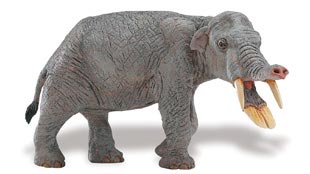Safari Prehistoric Life Series Models
For some years, the American model company Safari Ltd has offered a small range of prehistoric mammal models to accompany its Carnegie and Wild Dinos ranges. These models have been sold under the brand Safari Prehistoric Life models. Like many manufacturers, the emphasis on dinosaurs and animals of the Mesozoic is clearly seen in the model portfolio, but it is refreshing to note that some of the more unusual and lesser known prehistoric mammals are included in this part of their range.
Safari Prehistoric Life Models
The recent retirements of a couple of the prehistoric animal models has diminished the number available, but they do still manufacture the Amebelodon (prehistoric elephant) and an Andrewsarchus model. Andrewsarchus was a bizarre, hoofed carnivore, regarded by many palaeontologists as the biggest mammalian land carnivore of all time.
Known only from fossilised jaws and elements of the skull, the overall size and shape of Andrewsarchus has been based on the fossils of a smaller but closely related animal Mesonyx. This particular prehistoric beast, estimated at being more than 5 metres long and weighing perhaps as much as a small car, was named in honour of Roy Chapman Andrews, the American explorer and naturalist who led the expedition on which the fossils were found.
To read more about the adventurer Roy Chapman Andrews: Remembering Roy Chapman Andrews.
A Scale Drawing of Andrewsarchus

Picture credit: Everything Dinosaur
To view the Wild Safari Prehistoric Life model range in stock at Everything Dinosaur’s award-winning website: Safari Ltd. Wild Safari Prehistoric World Models.
It is always a pleasure to see some of the more unusual prehistoric animals represented in a model series. For example, as well as the Andrewsarchus, the Safari Prehistoric Life series (Wild Safari Dinos) boasts an Amebelodon model elephant amongst its collection.
Amebelodon
Like most primitive elephants Amebelodon had tusks in both its upper and lower jaws. This ancient elephant, whose remains have been found in the USA, as well as Africa, Asia and Europe lived during the Late Miocene Epoch (9-6 million years ago). It is usually spelt Amebelodon, however, the label on the Safari model carries the American spelling Ambelodon (the missing “e”). This is a good way of determining whether the company or individual selling or showing the model knows their stuff. As technically the accepted form for the name is Amebelodon (A. fricki). Any company with a missing “e” as it were, does not know their prehistoric elephants.
The Safari Wild Dinos Amebelodon Model







Leave A Comment